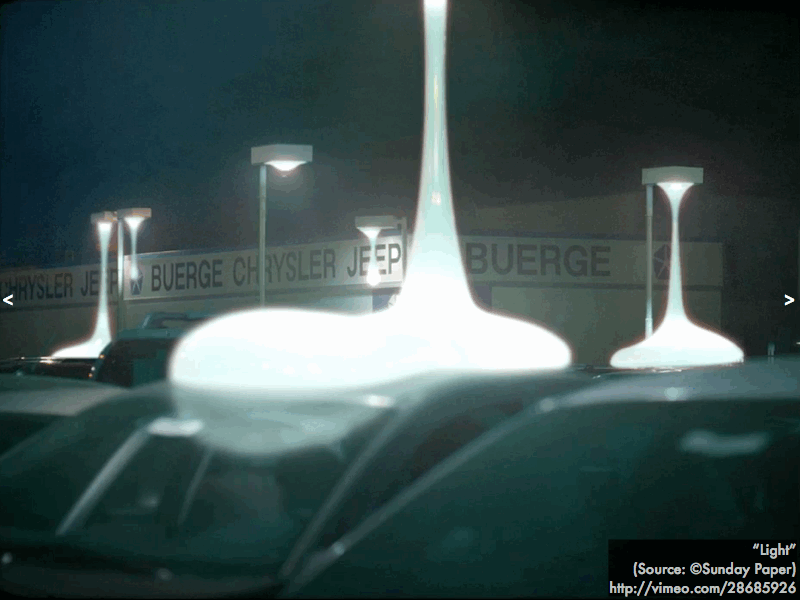 This is the ultimate horror movie scenario, at least to an astronomer. Literally, man-made lights polluting the environment, and ruining views of the dark night sky.
This is the ultimate horror movie scenario, at least to an astronomer. Literally, man-made lights polluting the environment, and ruining views of the dark night sky.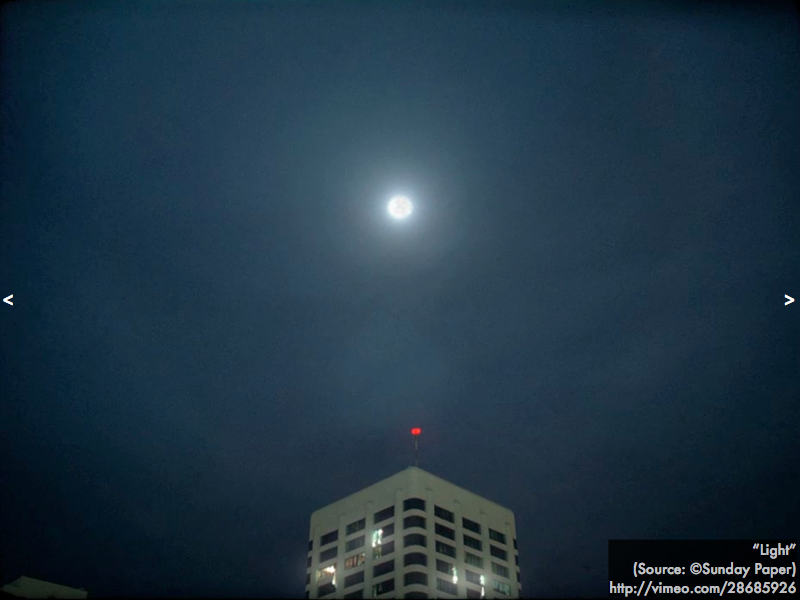 But since there is always a twist at the end of a horror movie, there is a older, far more prevalent threat on the rise. (Video link: "Light.")
But since there is always a twist at the end of a horror movie, there is a older, far more prevalent threat on the rise. (Video link: "Light.") 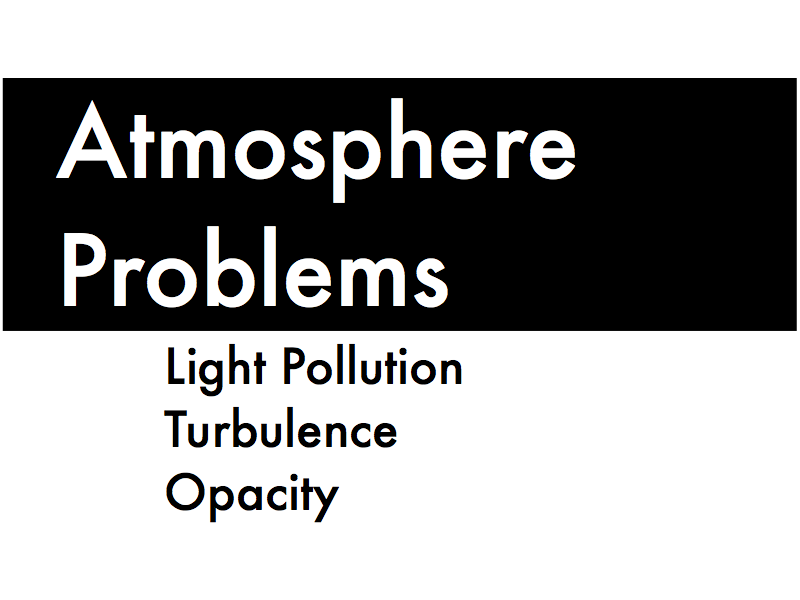 Following our previous presentation on optical telescopes, we will discuss problems that Earth's atmosphere presents to astronomical viewing, as well as solutions to these problems.
Following our previous presentation on optical telescopes, we will discuss problems that Earth's atmosphere presents to astronomical viewing, as well as solutions to these problems.  First, light pollution.
First, light pollution.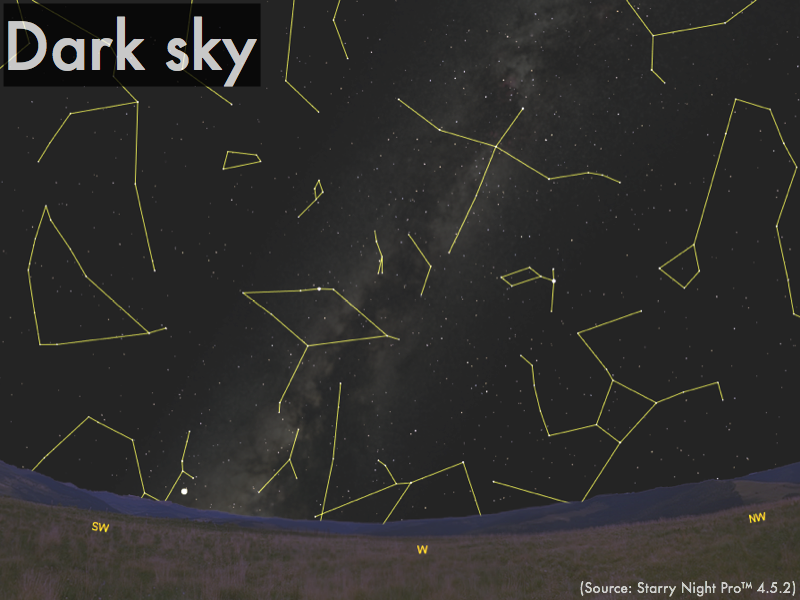 In a remote, rural location, the night sky will be dark enough to make out the very faint stars, and the Milky Way.
In a remote, rural location, the night sky will be dark enough to make out the very faint stars, and the Milky Way.  However, both light from both man-made (from streetlights) or natural (the moon) sources will be reflected by particles in the atmosphere, and interfere with light from the faint stars, washing them out. The sky itself will no longer be completely black, with a faint "skyglow" of atmosphere-reflected light.
However, both light from both man-made (from streetlights) or natural (the moon) sources will be reflected by particles in the atmosphere, and interfere with light from the faint stars, washing them out. The sky itself will no longer be completely black, with a faint "skyglow" of atmosphere-reflected light.  Thus light pollution is in part due both to stray source of light as well as the atmosphere. We can't get rid of the atmosphere, but as long as we can relocated telescopes away from urban areas, we can solve the problem of light pollution.
Thus light pollution is in part due both to stray source of light as well as the atmosphere. We can't get rid of the atmosphere, but as long as we can relocated telescopes away from urban areas, we can solve the problem of light pollution. 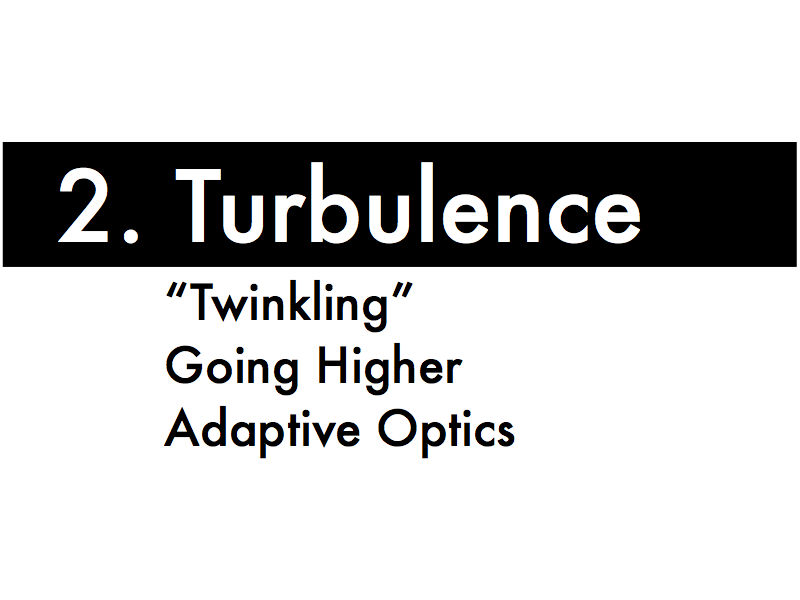 Second, atmospheric turbulence.
Second, atmospheric turbulence.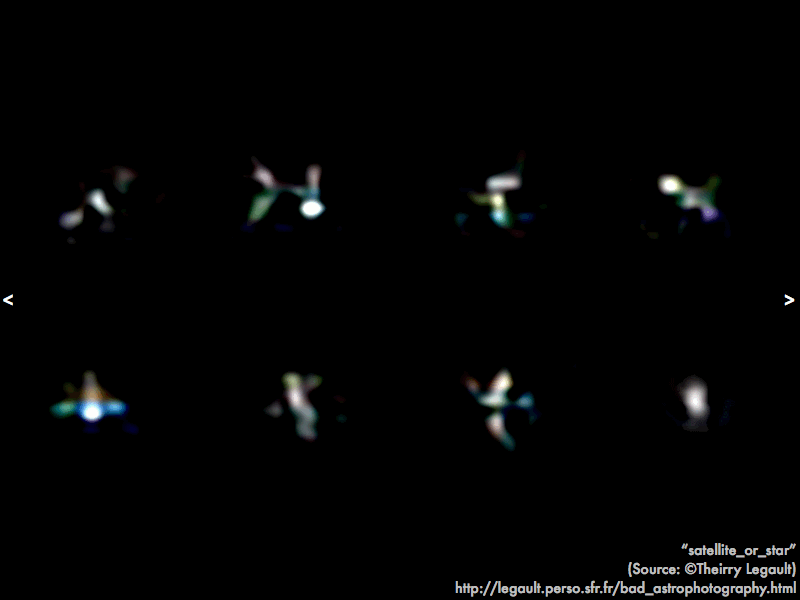 Astrophotographer Thierry Legault produced these high-magnification images--which of these are low Earth orbit satellites, and which are actually stars? Answer: they are actually all pictures of stars as they "twinkle."
Astrophotographer Thierry Legault produced these high-magnification images--which of these are low Earth orbit satellites, and which are actually stars? Answer: they are actually all pictures of stars as they "twinkle." Imagine holding your breath underwater, and looking up at the scenery above--if the water surface were absolutely calm, you would see a pretty clear view. But any ripples or motion in the water, and your view would be distorted. We literally live at the bottom of an ocean of air, such that any turbulence in the atmosphere will stir up the air, and distort astronomical viewing.
Imagine holding your breath underwater, and looking up at the scenery above--if the water surface were absolutely calm, you would see a pretty clear view. But any ripples or motion in the water, and your view would be distorted. We literally live at the bottom of an ocean of air, such that any turbulence in the atmosphere will stir up the air, and distort astronomical viewing. 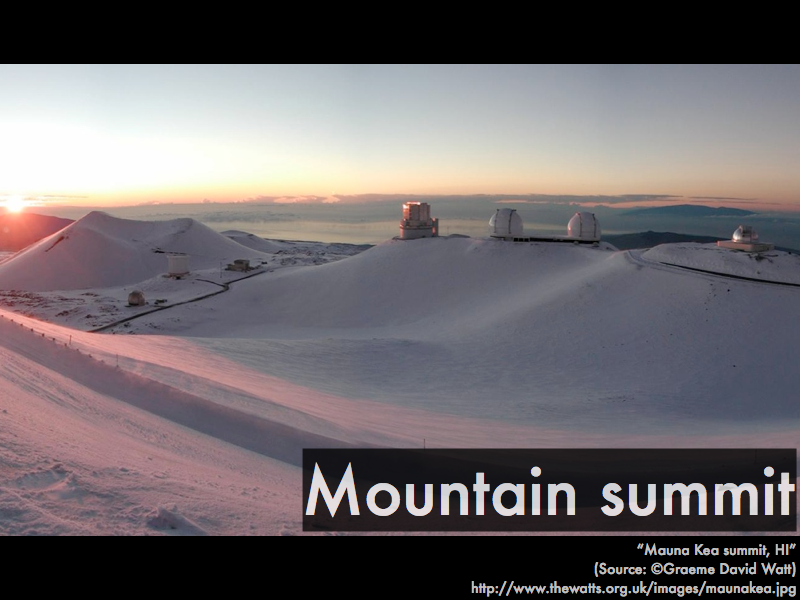 So how to solve this problem? You can't get rid of the atmosphere, but you could avoid it by putting a telescope in space, but there are much cheaper solutions. The first is to place your telescope as high as possible, where the air is thin, such that there is not much atmosphere above you. This doesn't completely avoid the effects of atmosphere turbulence, but it helps a lot.
So how to solve this problem? You can't get rid of the atmosphere, but you could avoid it by putting a telescope in space, but there are much cheaper solutions. The first is to place your telescope as high as possible, where the air is thin, such that there is not much atmosphere above you. This doesn't completely avoid the effects of atmosphere turbulence, but it helps a lot.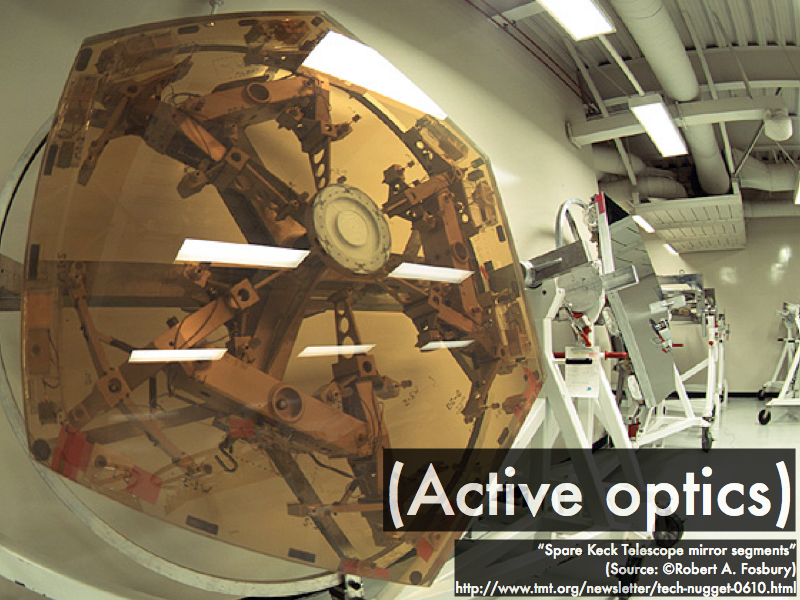 There is an even more effective method that nearly wipes out all effects of atmosphere turbulence, that developed out of solving another problem in making large reflectors. These are mirror segments from the Keck Telescopes, and notice that behind the segment that does have its reflective coating on it there are adjustable supports. In order to maintain the correct shape, it is easier to have a computer carefully adjust the supports in back using active optics, rather than to make a very thick, rigid, and heavy slab.
There is an even more effective method that nearly wipes out all effects of atmosphere turbulence, that developed out of solving another problem in making large reflectors. These are mirror segments from the Keck Telescopes, and notice that behind the segment that does have its reflective coating on it there are adjustable supports. In order to maintain the correct shape, it is easier to have a computer carefully adjust the supports in back using active optics, rather than to make a very thick, rigid, and heavy slab.  Adaptive optics takes this a step further--the secondary mirror of a telescope is smaller and can be made very flexible, with many computer-controlled supports behind it. The computer knows that stars should be point-like objects, so it will bend the mirror in real-time to warp a twinkling image (on the left) back to its proper undistorted shape (on the right). This may seem trivial for merely imaging stars, but is very valuable for things that we don't know the true shape for--if the stars around are corrected back to points of light, then the nebulae or galaxy in the same view should also be undistorted as well, with twinkling essentially "scrubbed" out of it. (Video link: "speckle8ao.mpg.")
Adaptive optics takes this a step further--the secondary mirror of a telescope is smaller and can be made very flexible, with many computer-controlled supports behind it. The computer knows that stars should be point-like objects, so it will bend the mirror in real-time to warp a twinkling image (on the left) back to its proper undistorted shape (on the right). This may seem trivial for merely imaging stars, but is very valuable for things that we don't know the true shape for--if the stars around are corrected back to points of light, then the nebulae or galaxy in the same view should also be undistorted as well, with twinkling essentially "scrubbed" out of it. (Video link: "speckle8ao.mpg.")  Third, opacity.
Third, opacity.  So far we have been discussing atmospheric problems for optical telescopes--light-pollution and turbulence, which can be solved using certain techniques. However, the atmosphere itself presents a problem to other forms of electromagnetic radiation, especially infrared (which is emitted by stars and planets while they form), ultraviolet and x-rays (from dying and dead stars). You do not have to memorize this diagram--it will be provided to you on quizzes and exams--but know how to interpret and use it, especially during the subsequent in-class activity. If the top of this diagram is space, and the bottom is sea level, then the gray bars represent how far down through the atmosphere these different types of electromagnetic radiation travel. Visible and radio waves will make it all the way through the atmosphere, but infrared, ultraviolet, and x-rays are blocked in the upper atmosphere, unable to make to sea level.
So far we have been discussing atmospheric problems for optical telescopes--light-pollution and turbulence, which can be solved using certain techniques. However, the atmosphere itself presents a problem to other forms of electromagnetic radiation, especially infrared (which is emitted by stars and planets while they form), ultraviolet and x-rays (from dying and dead stars). You do not have to memorize this diagram--it will be provided to you on quizzes and exams--but know how to interpret and use it, especially during the subsequent in-class activity. If the top of this diagram is space, and the bottom is sea level, then the gray bars represent how far down through the atmosphere these different types of electromagnetic radiation travel. Visible and radio waves will make it all the way through the atmosphere, but infrared, ultraviolet, and x-rays are blocked in the upper atmosphere, unable to make to sea level.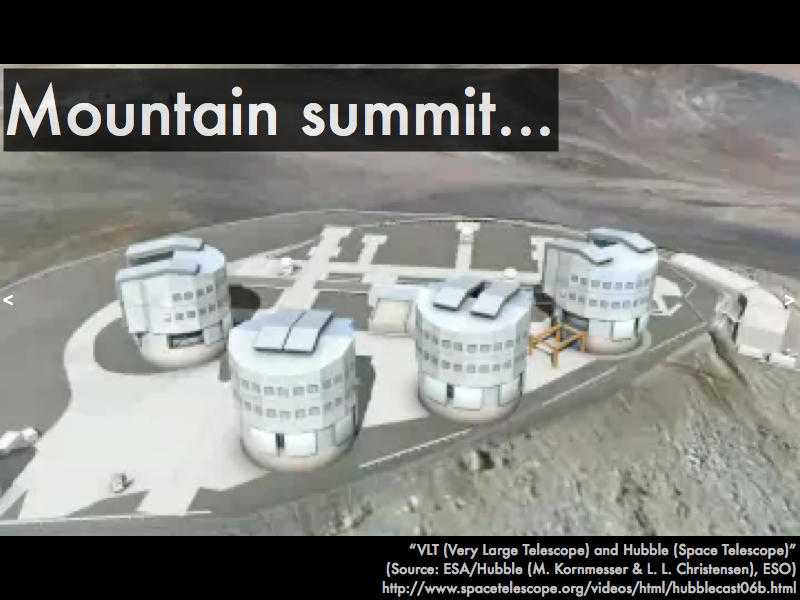 The solution to detecting the forms of electromagnetic radiation blocked by the atmosphere is then to go higher--placing telescopes on mountain summits allows some to be detected...
The solution to detecting the forms of electromagnetic radiation blocked by the atmosphere is then to go higher--placing telescopes on mountain summits allows some to be detected...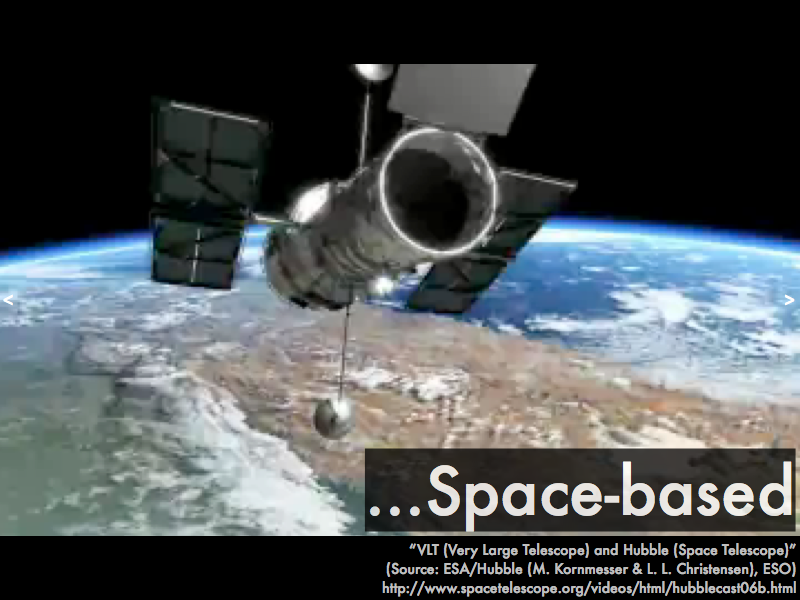 ...or perhaps placing telescopes in space, in order to avoid the opacity of the atmosphere altogether. (Video link: "VLT and Hubble.")
...or perhaps placing telescopes in space, in order to avoid the opacity of the atmosphere altogether. (Video link: "VLT and Hubble.") However, space telescopes are effective but very expensive, and mountain-based telescopes are cheaper but not quite as effective.
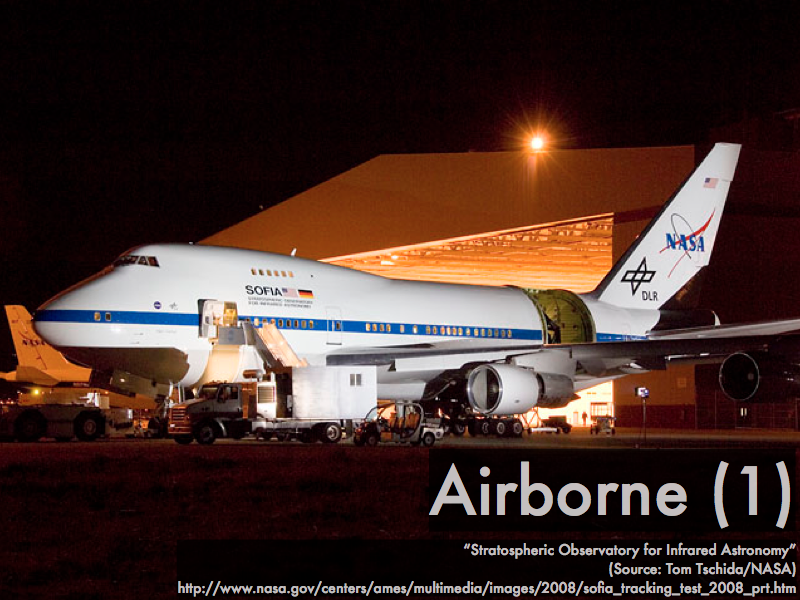 A compromise is to place telescopes on balloons, or on aircraft. The latest development is to place a infrared telescope on a refurbished airliner, based in San Jose, CA.
A compromise is to place telescopes on balloons, or on aircraft. The latest development is to place a infrared telescope on a refurbished airliner, based in San Jose, CA. 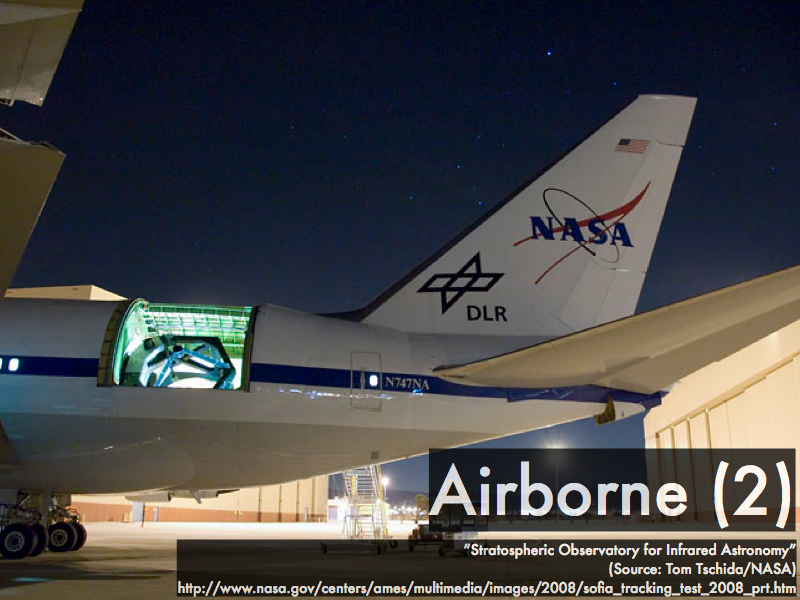 The back of the SOFIA (Stratospheric Observatory for Infrared Astronomy) airliner rolls back during flight, such that a gyroscopically-stabilzed infrared telescope can make high-altitude observations much better than atop a mountain, and much cheaper than in space.
The back of the SOFIA (Stratospheric Observatory for Infrared Astronomy) airliner rolls back during flight, such that a gyroscopically-stabilzed infrared telescope can make high-altitude observations much better than atop a mountain, and much cheaper than in space.
No comments:
Post a Comment